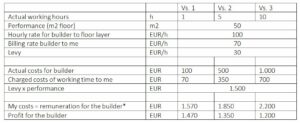It has been sufficiently clarified by now that time is money. But: whose time and whose money are we talking about? If the client wants to have a tunnel built as quickly as possible for as little money as possible, but the contractor wants as much money as possible for as little effort as possible, this harbors potential for conflict. With the time and performance-based compensation model “StilfOs”, construction projects could be carried out more cost-effectively and productively for both parties, says Dr. Michael Werkl from BWI Consulting Industrial Engineers for Construction GmbH.
*****
I’ve never been a fan of group work. Bringing several ways of working and thinking under one roof is difficult enough, but when each group member also has a different goal (personally I belong to the group which strives to achieve a positive grade with as little effort as possible; but for some reason unknown to me every group always also has a member of the “I want 100 percent party” and the party “Now I get to say more than you during the presentation, that’s not fair”), it gets really complicated.

It is similar with construction projects. While the client wants to handle his project as cheaply as possible, the contractor wants to get the highest possible price for his service. “In this area of tension, a remuneration and contract model develops – mostly based on the client – that should balance the opposing interests of the two contracting parties as well as possible. The increasing number of disputes about remuneration issues in construction shows, however, that conventional models often cannot optimally regulate the exchange of performance and remuneration, ”says Dr. Werkl.
An alternative is needed
Instead, what the industry needs is an alternative that, in Werkl’s opinion, is ideally based on incentives rather than penalties. One such method is the StilfOs model. “The use of StilfOs is generally recommended when time-dependent remuneration elements make up a significant part of the service. This is particularly the case with special civil engineering work. Successful use on many injection construction sites has paid off for both parties to the contract. “
[Note: Simply put, time-dependent factors are things (people as well as device costs) for which an hourly or monthly rate is charged, so the longer they are needed, the more expensive they get.]

Zugegeben, der Name geht nicht unbedingt ins Ohr. StilfOs setzt sich zusammen aus Stilfontein Goldmine in der ehem. Provinz Transvaal in Südafrika und dem Oswaldibergtunnel in Kärnten, wo es in Österreich 1987 zum ersten Mal zum Einsatz kam. Wie wäre es stattdessen mit WSM (We Save Money)? (Monetäre Einsparungen Für Alle)? Nett klingt auch mein persönlicher Favorit, ProST (produktiver Spezialtiefbau). Oder natürlich LoVe (Leistungsorientiertes Vergütungssystem)?
Admittedly, the name is not very catchy. StilfOs is made up of the Stilfontein gold mine in the former Transvaal province in South Africa and the Oswaldibergtunnel in Carinthia, where it was first used in Austria in 1987.
However, it is not due to the unusual name that the model has so far not been able to prevail over others, says Dr. Werkl. “In my opinion, the reason for this is the fact that the model was often explained in too complicated a way. Those who have used the model, however, all report advantages for both contractual partners, ”emphasizes Dr. Werkl, who already devoted his diploma thesis at the Technical University (TU) Graz to the subject.
Challenge accepted! We make StilfOs easy to understand and start with an explanation that also makes Die Sendung mit der Maus go pale with envy!
StilfOs explained

In order to explain the model as simply as possible, we have transferred it from special civil engineering to another area of life, namely a comparatively simple apartment renovation:
The usual approach would be for me to hire a builder to provide me with a flat-rate estimate, which I accept. The risk here is that the renovation work will be delayed or turns out to be more difficult than originally planned by him, and thus his hourly wage will decrease. As an alternative to a cost estimate, he could offer me an hourly rate. But then I, as the client, may have the problem that the builder delays the work due to his particularly slow way of working and the costs increase for me.
If, on the other hand, we were to design my renovation work according to the StilfOs principle, the costs would be divided into three points in a simplified manner:
- 1.) Flat rate
There is a basic flat rate that covers certain standard services once (for example planning, commissioning the various trades, delivering the materials to my apartment and the final cleaning – costs that can be calculated very easily.
- 2.) Time-dependent factors such as equipment & personnel
A certain hourly rate is generally charged for these. So far not unusual. However, the hourly rate charged is below the builder’s cost.
For example, the builder himself pays 100 euros / hour for his floor layer, but he only bills me 70 euros. At first glance this is a loss for him.
But of course the difference is not lost – because it is taken as a surcharge to the next invoice item, the Performance:
- 3.) Performance
The Performance includes all components such as the installed square meters of parquet and is only billed when a service is actually provided.
So if the floor layer is not performing (because I did not care to provide electricity OR because the builder wasted time by exchanging holiday photos with him), there is no service either.
As soon as the service is provided, i.e. the floor is laid, a fee per square meter PLUS the surcharge calculated by the time-dependent factors is due.
So I am very motivated to ensure that the construction site runs smoothly and to make the necessary decisions quickly – otherwise I will pay unnecessarily for time-dependent factors (point 2). The builder is just as interested in working productively, since he works for the purely time-dependent factors below his own cost – i.e. makes a loss if he cannot make up for this with the corresponding surcharge on the services (point 3).

Calculated using the example of the floor layer, the costs for the renovation could look as follows:

* This point is calculated from the installed amount of parquet (50m2) in combination with the levy (30 euros) -so 1,500 euros- PLUS the respective costs charged for working time to me by the client (i.e. 70 euros for variant 1, 350 euros for variant 2 and 700 euros for variant 3).
It is very easy to see: If the work takes longer, it becomes more expensive for everyone involved. The more productive you work, the better it is for everyone.
Easily built into unit price contracts
StilfOs can easily be implemented in a unit price contract as part of a tender. “The essential service items are singled out, with the allocation of the time-dependent portions in the selected amount then being made to these items. In turn, unit prices are billed, which have been modified accordingly by the allocation of the StilfOs model ”, says Dr. Werkl. The effort is “limited if you convert the time-related costs to the essential service items.”
No risk, much fun
Everything speaks in favor of StilfOs. So why is it still rarely used? This is where the human factor comes into play. “In practice, the assessment of risk is always only possible by taking probabilities into account (probabilities of occurrence), which is difficult for us humans,” says Dr. Werkl. The result are irrational decisions made on the basis of gut instinct.
What is the probability of getting into contact with a floor installer who does not realize that he is paying extra himself if he works unproductively? In reality it is very unlikely, but in the mind of the client (for example due to negative personal experiences) the probability it is much higher. The same applies to the craftsman, who may have had to deal with uncooperative customers on his last three construction sites, because of which he has a negative attitude towards the current client. With the StilfOs remuneration model, both parties are interested in productive work, because otherwise they both pay extra.
“When we surveyed risk awareness with regard to remuneration models, we found that many persons involved actually make irrational decisions when they make uncertain decisions. Dealing with the topic of probability is very difficult for many people and logical decisions are not always made, ”said Dr. Werkl. “Since the interests of alternative remuneration models such as StilfOs are brought into line, the overall risk for both contracting parties can be minimized.”
Together into the future
Basically it is the task of the two contractual partners to agree on the level of the levy and the resources to be jointly determined. However, the determination is only successful if the client also has technical and operational know-how, says Dr. Werkl. He is sure that a partnership approach not only in monetary matters will gain more and more importance in the future in the construction industry.
Our blog entry shows: In complex work, an alternative model is beneficial for everyone. Dr. Werkl has already been able to observe that the construction industry is moving in the direction of partnership-based project management. Specifically, he attaches this development to the fact that, for example, the Austrian Construction Technology Association (ÖBV) published a guideline for alternative contract models in May 2021, in which the StilfOs model is also mentioned.
*****
If you want to know more about StilfOs, it is best to read Dr. Werkl’s article about this in the December 2020 issue of VÖBU magazine.
*****
About Dr. Michael Werkl:
Michael Werkl was already fascinated by the interface between technology and business during his studies at Graz University of Technology (industrial engineering – civil engineering). Like many others, he was seduced by the lectures of Professor Gert Stadler (who brought StilfOs to Austria and the Graz University of Technology …) to special civil engineering, where he was able to handle exciting projects in Europe with Insond / Züblin.
He was particularly interested in the topic of risk in special civil engineering, which ultimately led to him spending an additional four years with a corresponding dissertation at TU Graz to investigate how people deal with the assessment of probabilities and risks.
The entry into the construction industry consulting took place immediately afterwards and, after passing the examination to become an expert, led to the foundation of the BWI Beratende Wirtschaftsingenieure für Bauwesen GmbH, which he now leads as a managing partner. His focus is on the construction industry support of projects and expert work in international arbitration proceedings. Dr. Werkl is involved as an author of specialist publications and lectures on construction-related issues.
The passionate tennis player is married, has two children, lives and works – if not internationally – in Graz.

